LTE IoT Market Size
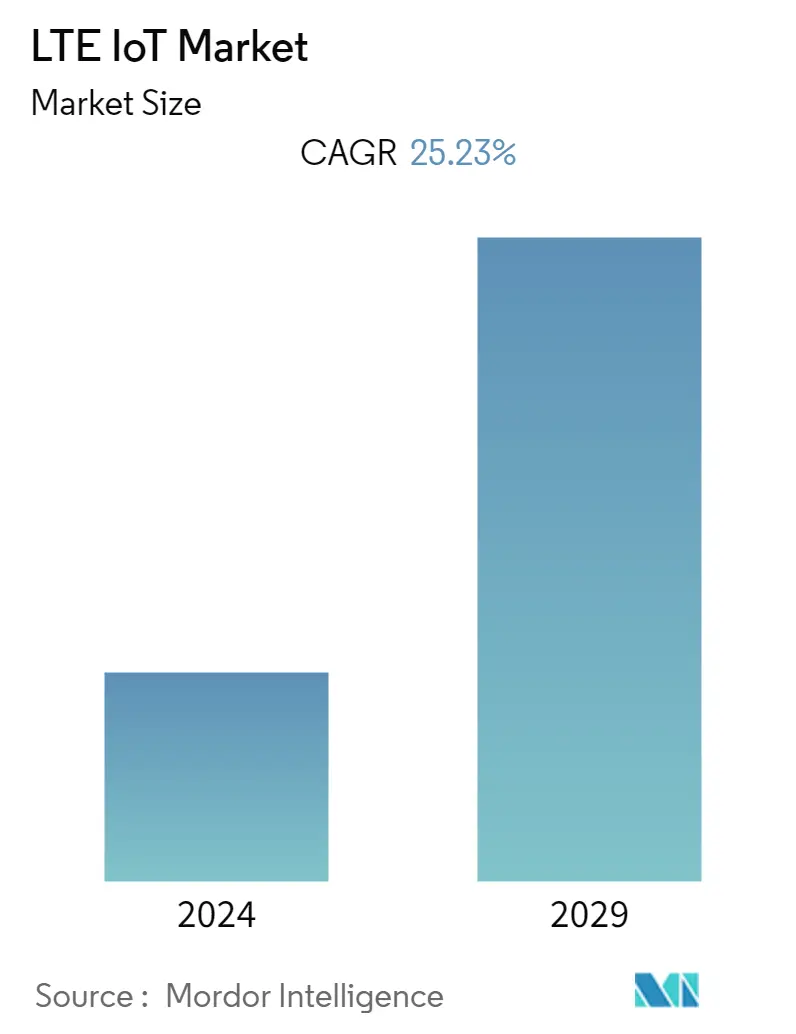
| Study Period | 2019 - 2029 |
| Base Year For Estimation | 2023 |
| CAGR | 25.23 % |
| Fastest Growing Market | Asia Pacific |
| Largest Market | Europe |
| Market Concentration | High |
Major Players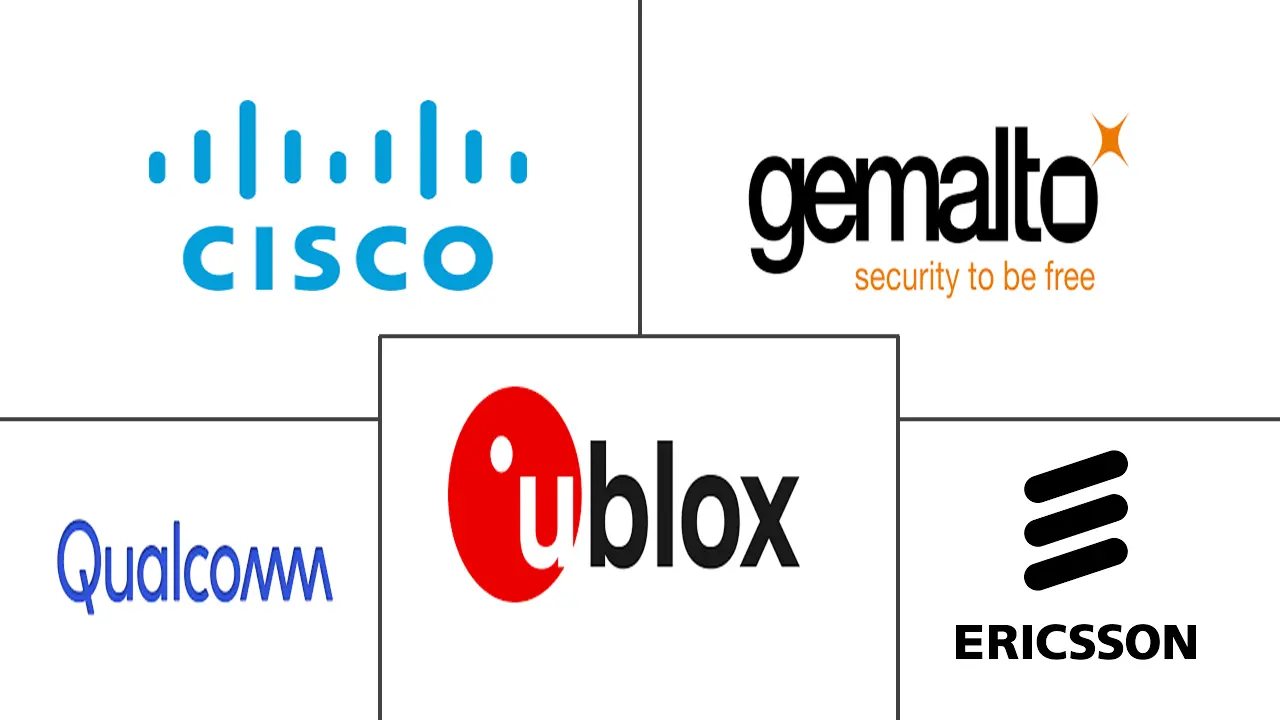
*Disclaimer: Major Players sorted in no particular order |
LTE IoT Market Analysis
LTE IoT Market will register a CAGR of over 25.23% during the forecast period. The growth of connected devices and the need for unique and defined network qualities fuel the development of the LTE IoT market.
- The managed service provider offers customers comprehensive and cost-effective solutions, thereby delivering their expertise in handling various operating activities (including infrastructure management, security operations, and cloud operations) to clients, enabling them to launch multiple Machine-to-Machine (M2M) offerings.
- Due to the delicate nature of manufacturing operations, manufacturers are adopting IoT solutions, sensors, and wireless connectivity platforms to increase their productivity, transforming their operations into smart manufacturing.
- Many software and solution providers offer industries smart manufacturing applications that include proactive and automatic analytics capabilities, making industrial manufacturing an intelligent and self-manageable environment. The LTE technology is availed to establish stable connectivity among various devices in a factory for data transmission, to enable industries to tackle the issues related to predictive maintenance and autonomous production.
- However, the market observed highly region-specific challenges. The enterprises demanding to deploy an IoT project within the United States have to be based on the LTE-M network due to the predominant presence of LTE radios. LTE CAT M1 devices' presence in Asia, Africa, and Eastern Europe is because mobile network operators still use 3G connectivity. However, NB-IoT devices can be found in abundance across Asia, especially in China, due to the presence of low-cost device manufacturers.
- The spread of COVID-19 has impacted many sectors that are the main markets for LTE IoT technology. The construction sector is witnessing a slower growth rate due to COVID; many running projects need to be stalled or canceled. This stops the further installation of IoT devices, such as smart street lights, meters, and parking meters. Moreover, the pandemic also affected the consumer and retail market; the sales of smart devices and smart appliances declined. All these devices actively use NB-IoT Chipset.
LTE IoT Market Trends
This section covers the major market trends shaping the LTE IoT Market according to our research experts:
Industrial Sector is Expected to Grow at a Significant Rate
- The IoT transforms how organizations communicate and regulate their everyday businesses and industrial processes. Its widespread adoption across industries has proven well-suited for sectors that manage many assets and coordinate complex and distributed operations.
- Due to the complexity and diversity of industrial requirements, numerous communication systems are required. With new technologies in place, current warfare is now referred to as network-centric warfare, wherein a robustly networked architecture improves information sharing, enhancing the quality of information and shared situational awareness. Such extended applications and serviceability of the market type have helped it to create a demand specific to the market and end users' needs.
- Flexibility, interoperability, and longevity are critical characteristics of networked communications for the LTE applications that are helping to create demand for the end users, maintaining close coordination within the team and across an adjacent and higher operating units in industries. With the advancement in the LTE and the development of IoT, the market's future holds a lot of promise for enhanced situational awareness via voice, video, and data delivered not only limited to the emergency operations/dispatch of services but also first responders in the field.
- IoT devices' rapid automation and development in harsh and dangerous environments, such as oil rigs, underwater pipelines, off-shore platforms, blast furnaces, etc., will boost the demand for LTE IoT devices and sensors.
- The NB-IoT technology is also widely used for manufacturing purposes. LTE-M and NB-IoT, the two IoT technologies, are well-suited to enable cost-effective, secure, and dependable connectivity to large machinery with a long lifespan. Both technologies can penetrate deep inside factory structures, allowing connectivity to reach machines below ground level and other inaccessible areas. For instance, the Wanxiang group in China uses China Unicom's NB-IoT network to monitor the manufacturing of automotive parts to ensure quality traceability.
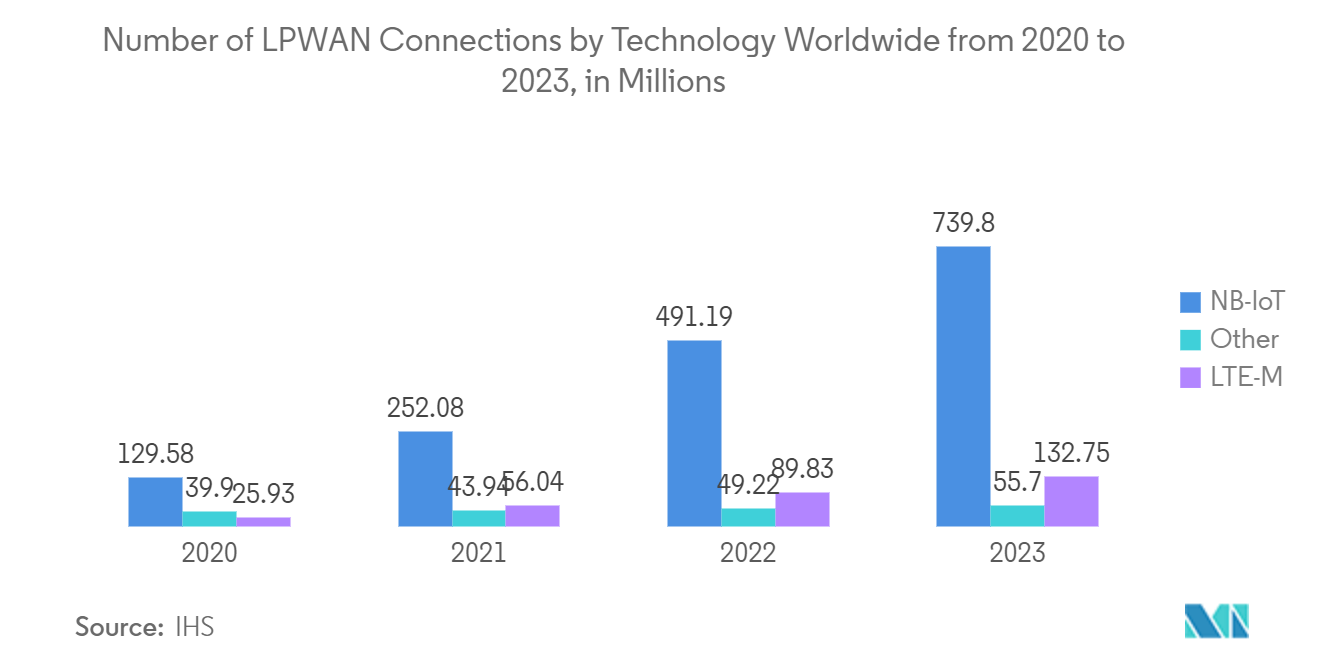
Europe holds a Significant Market Share
- Europe is gaining the LTE IoT market presence owing to the widespread adoption of LTE technology for enterprises' IoT applications. The well-established company of some prominent players across the region, such as Telefonaktiebolaget LM Ericsson, Halberd Bastion Pty Ltd, and u-blox AG, among others, is expected further to assist the regional market in the overall growth.
- The region is leading in terms of the LTE IoT coverage area, with some of the ongoing development by prominent players across the region fueling the demand across the region. For instance, Huawei and Vodafone opened an open lab in Newbury, UK, for R&D of LTE IoT technologies and applications.
- European Commission and European Union member states are committed to developing strategies to support experiments and the deployment of IoT telecom and allied services. Various cellular operators are also set for the widespread deployment of LTE IoT in the UK and the rest of Europe, where Germany, the UK, and France are the top 3 contributors to the LTE IoT market in Europe. Further, Mobile Network Operators (MNOs) have also deployed several pre-commercial trials and plots across Europe.
- The European country's reliance on the latest technology to maintain its competitiveness and business efficiency are the major reason for the rapid acceptance of LTE IoT in European Industries. These devices have wide applications in construction, logistics and fleet management, energy, manufacturing, etc. For instance, the construction industry finds wide applications for Temperature, Humidity, motion, and light sensors.
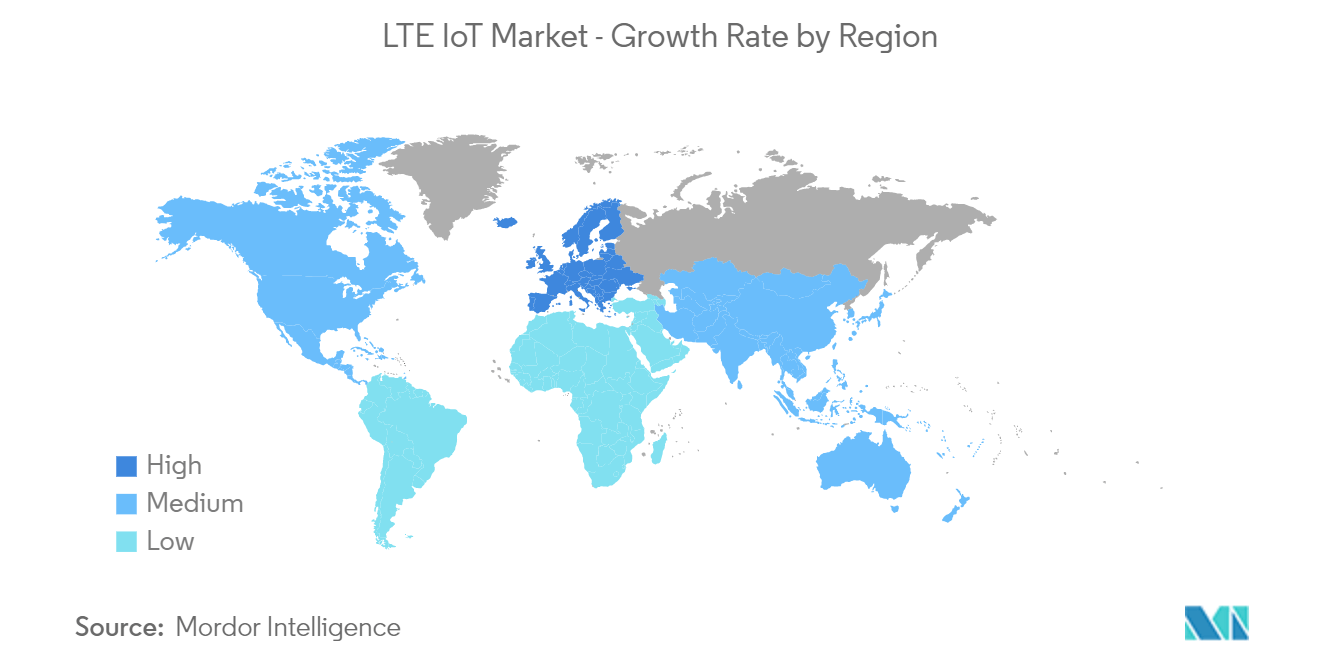
LTE IoT Industry Overview
The LTE IoT market is highly consolidated and consists of several significant players. Regarding market share, some of the major players currently dominate the market. However, with the advancement in the industrial IoT application across multiple end-user industries, new players are increasing their market presence, thereby expanding their business footprint across emerging economies.
- December 2022 - Aeris Communications and Ericsson joined together to create a leader in the fast-growing IoT industry. The combination of Aeris and Ericsson's IoT platforms will offer an unparalleled IoT platform for enterprises and new revenue streams for communication service providers by connecting over 100 million IoT devices worldwide, covering 190 countries, and providing IoT connectivity and software solutions to thousands of enterprises.
- June 2022 - Qualcomm launched a robust roster of cutting-edge IoT solutions by introducing seven new next-generation IoT devices: Qualcomm QCS8250, Qualcomm, QCS6490/ QCM6490, Qualcomm QCS4290/ QCM4290, and the Qualcomm QCS2290/ QCM2290. for key segments including transportation and logistics, warehousing, video collaboration, smart cameras, retail, and healthcare providing a portfolio of solutions to transform industrial and enterprise IoT applications to achieve cutting edge performance and seamless connectivity to drive global digital transformation across industries.
LTE IoT Market Leaders
-
Qualcomm Technologies, Inc
-
Gemalto N.V.
-
u-blox AG
-
Telefonaktiebolaget LM Ericsson
-
Cisco Syatem Inc. (Jasper)
*Disclaimer: Major Players sorted in no particular order
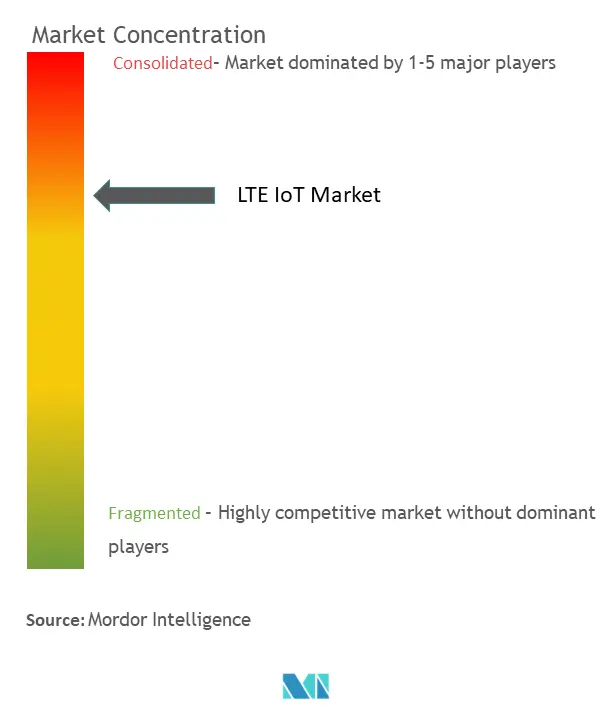
LTE IoT Market News
- June 2022 - System Loco selected the Aeris Intelligent IoT network to provide next-generation connectivity that includes LTE-M, NB-IoT, LTE, and 2G/3G coverage from 600 carriers globally to offer a dynamic and flexible connectivity solution that ensures that all demands from current and future networks are met to support and manage the worldwide track and trace of smart pallets employed by System Loco's customers throughout the world.
- April 2022 - UScellular Collaborated with Qualcomm and Inseego to Launch 5G mmWave High-Speed Internet Service to provide high-speed internet access wirelessly to customers' homes or businesses. Inseego Wavemaker FW2010 outdoor CPE delivers multi-gigabit download speeds for data-hungry applications and supports 5G sub-6 GHz and Cat 22 LTE, making it great for a wide range of locations and applications.
LTE IoT Market Report - Table of Contents
1. INTRODUCTION
- 1.1 Study Assumptions and Market Definition
- 1.2 Scope of the Study
2. RESEARCH METHODOLOGY
3. EXECUTIVE SUMMARY
4. MARKET INSIGHTS
- 4.1 Market Overview
-
4.2 Industry Attractiveness - Porter's Five Force Analysis
- 4.2.1 Bargaining Power of Suppliers
- 4.2.2 Bargaining Power of Consumers
- 4.2.3 Bargaining Power of Entrants
- 4.2.4 Intensity of Competitive Rivalry
- 4.2.5 Threat of Substitute Products
-
4.3 Technology Snapshot
- 4.3.1 Private LTE
- 4.3.2 Commercial LTE
- 4.3.3 Enterprise LTE
5. MARKET DYNAMICS
-
5.1 Market Drivers
- 5.1.1 Growing Demand for High-speed Broadband Connectivity
- 5.1.2 Rising Demand for the Industrial IoT among End-user Industries
-
5.2 Market Challenges
- 5.2.1 Scarcity of Spectrum Bandwidth
6. MARKET SEGMENTATION
-
6.1 By Service
- 6.1.1 Professional
- 6.1.2 Managed
-
6.2 By Product Type
- 6.2.1 NB-IoT (Cat-NB1)
- 6.2.2 LTE-M (eMTC Cat-M1)
-
6.3 By End-user Industry
- 6.3.1 IT & Telecommunication
- 6.3.2 Consumer Electronics
- 6.3.3 Retail (Digital Ecommerce)
- 6.3.4 Healthcare
- 6.3.5 Industrial
- 6.3.6 Other End-user Industries
-
6.4 By Geography
- 6.4.1 North America
- 6.4.2 Europe
- 6.4.3 Asia-Pacific
- 6.4.4 Rest of the World
7. COMPETITIVE LANDSCAPE
-
7.1 Company Profiles
- 7.1.1 Qualcomm Technologies, Inc
- 7.1.2 Gemalto N.V.
- 7.1.3 u-blox AG
- 7.1.4 Telefonaktiebolaget LM Ericsson
- 7.1.5 Cisco Syatem Inc. (Jasper)
- 7.1.6 Cradlepoint Inc.
- 7.1.7 Sequans Communications S.A.
- 7.1.8 PureSoftware
- 7.1.9 TELUS Corporation
- 7.1.10 MediaTek Inc.
- 7.1.11 Verizon Communications
- 7.1.12 AT&T Inc.
- *List Not Exhaustive
8. INVESTMENT ANALYSIS
9. MARKET OPPORTUNITIES AND FUTURE TRENDS
** Subject To AvailablityLTE IoT Industry Segmentation
Companies are actively working on IoT along with its high growth opportunities in multiple verticals across the market, ranging from healthcare to energy utilities and from automotive to robotics. The size of the 3GPP ecosystem is projected to further drive the commercialization of IoT, with mobile operators, infrastructure suppliers, chipset and module manufacturers, device companies, and development and testing houses supporting new services. In turn, this pushes operators to provide broadband solutions on both mobile networks under the scope of LTE-M and NB-IoT, thereby defining and creating new bundle plans with the help of combined mobile and fixed services.
The LTE IoT Market is segmented by Service (Professional, Managed), Product Type (NB-IoT, LTE-M), End-user Industry (IT & Telecommunication, Consumer Electronics, Retail (Digital Ecommerce), Healthcare, Industrial), and Geography (North America, Europe, Asia-Pacific, and Rest of the World).
The market sizes and forecasts are provided in terms of value (USD million) for all the above segments.
| By Service | Professional |
| Managed | |
| By Product Type | NB-IoT (Cat-NB1) |
| LTE-M (eMTC Cat-M1) | |
| By End-user Industry | IT & Telecommunication |
| Consumer Electronics | |
| Retail (Digital Ecommerce) | |
| Healthcare | |
| Industrial | |
| Other End-user Industries | |
| By Geography | North America |
| Europe | |
| Asia-Pacific | |
| Rest of the World |
LTE IoT Market Research FAQs
What is the current LTE IoT Market size?
The LTE IoT Market is projected to register a CAGR of 25.23% during the forecast period (2024-2029)
Who are the key players in LTE IoT Market?
Qualcomm Technologies, Inc, Gemalto N.V., u-blox AG, Telefonaktiebolaget LM Ericsson and Cisco Syatem Inc. (Jasper) are the major companies operating in the LTE IoT Market.
Which is the fastest growing region in LTE IoT Market?
Asia Pacific is estimated to grow at the highest CAGR over the forecast period (2024-2029).
Which region has the biggest share in LTE IoT Market?
In 2024, the Europe accounts for the largest market share in LTE IoT Market.
What years does this LTE IoT Market cover?
The report covers the LTE IoT Market historical market size for years: 2019, 2020, 2021, 2022 and 2023. The report also forecasts the LTE IoT Market size for years: 2024, 2025, 2026, 2027, 2028 and 2029.
LTE IoT Industry Report
Statistics for the 2024 LTE IoT market share, size and revenue growth rate, created by Mordor Intelligence™ Industry Reports. LTE IoT analysis includes a market forecast outlook 2029 and historical overview. Get a sample of this industry analysis as a free report PDF download.



